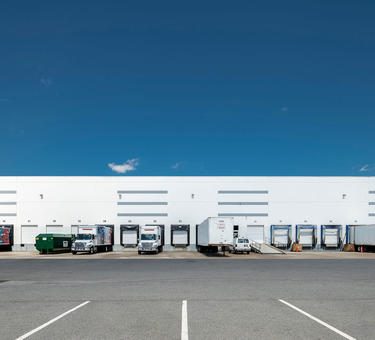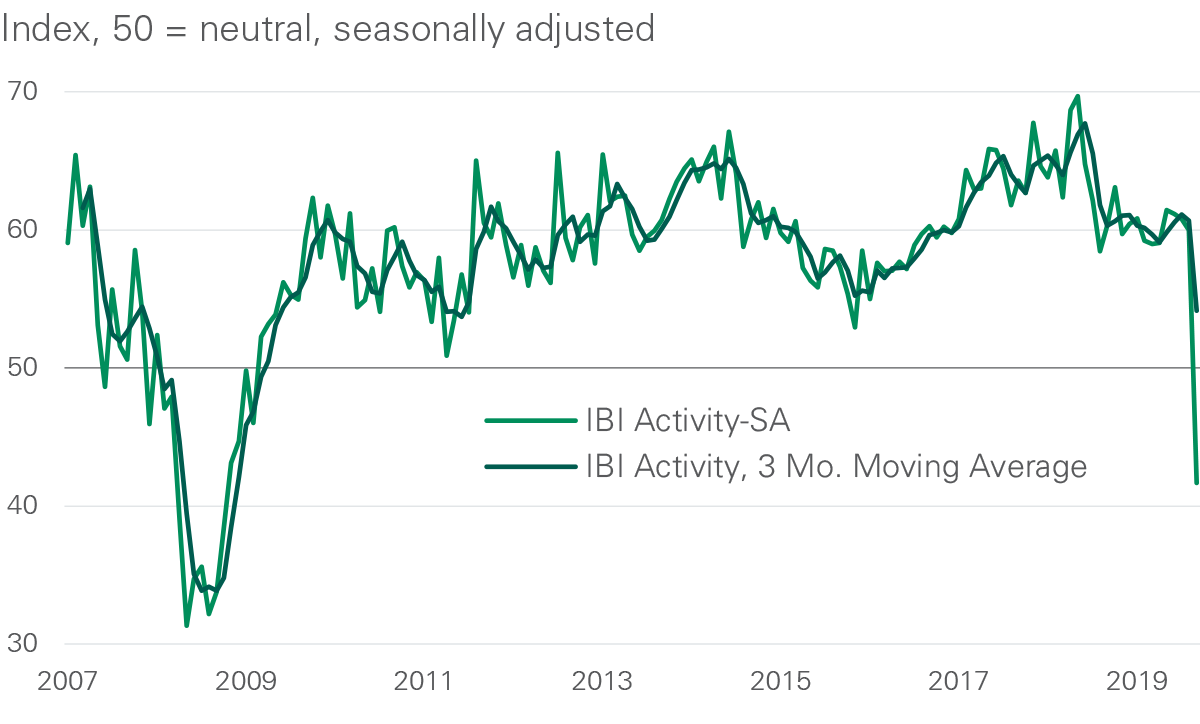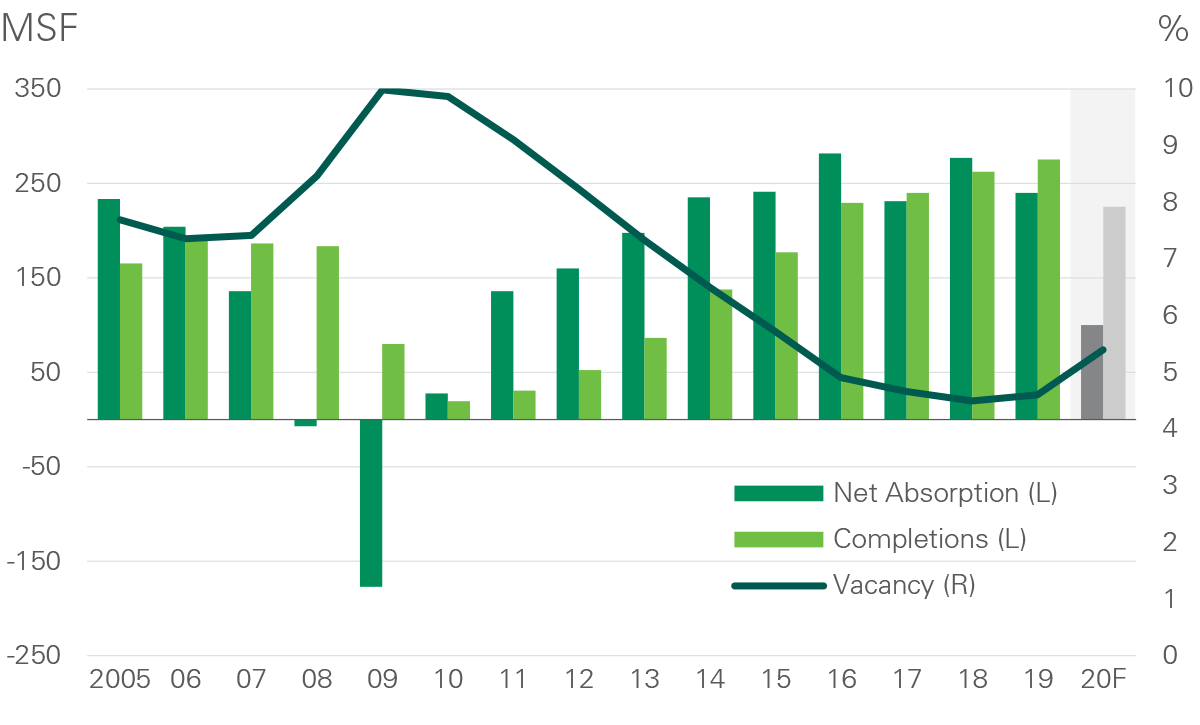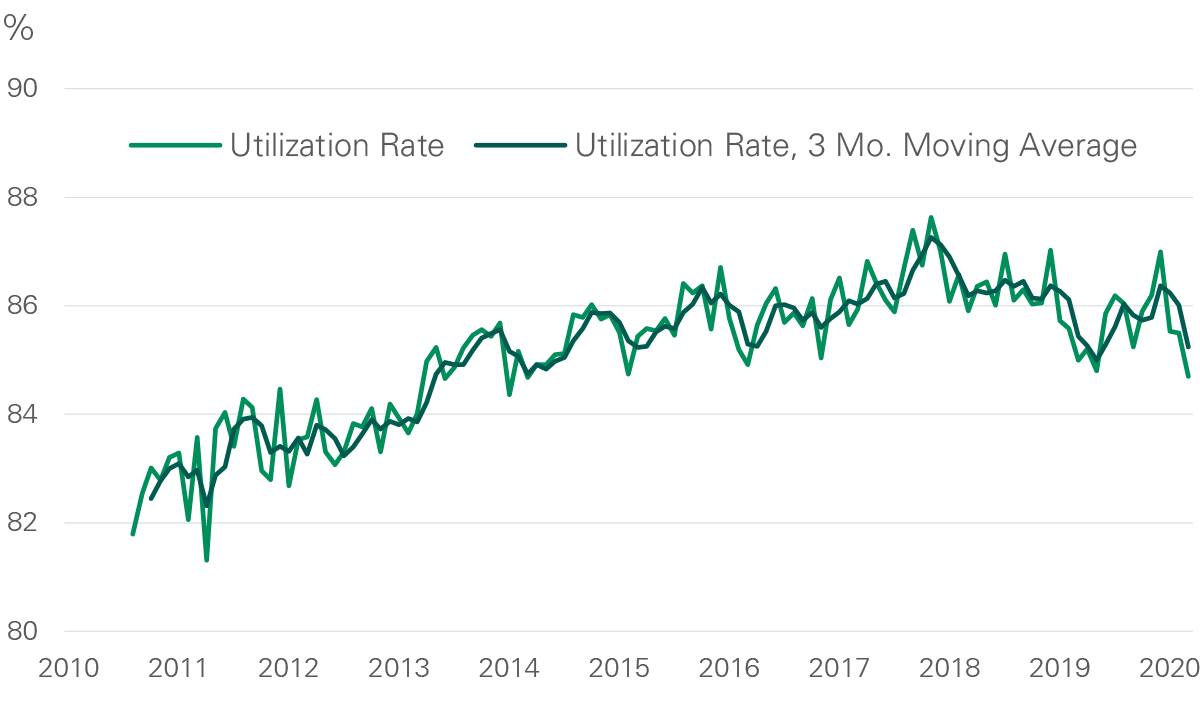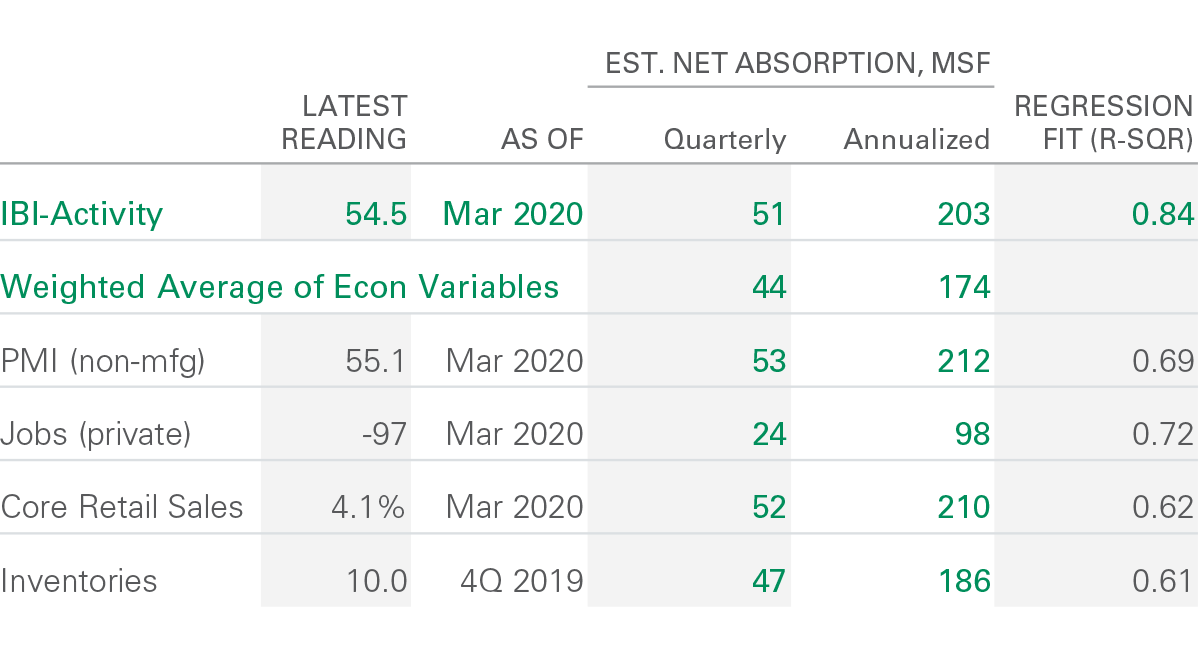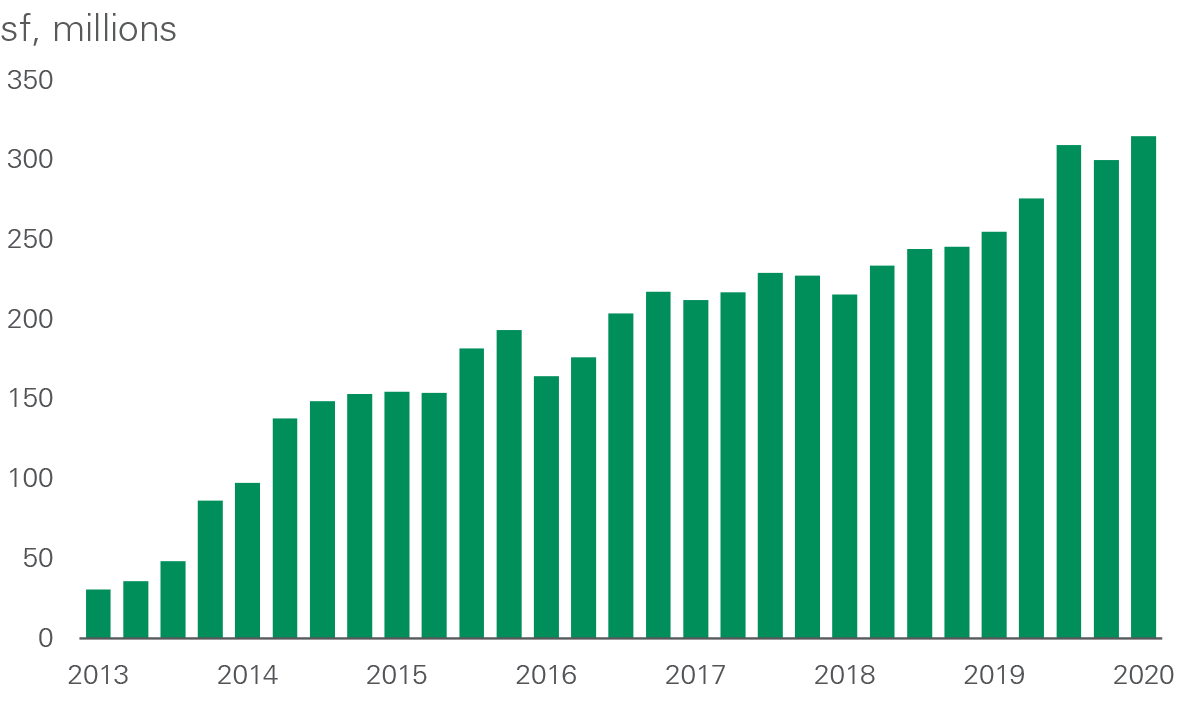
The Broad View
- Prologis’ latest IBI, the company’s quarterly survey of customer sentiment, fell in March to 41.7 after more than a year of consistently strong readings above 58. While this was the sharpest fall in the history of the index, the reading was still above GFC-era lows of ~30.
- Operating fundamentals entered the pandemic disruption in a position of strength, as market vacancy in the first quarter remained near its all-time low of 4.7%1. Market rental growth was approximately 1.2%2 in the first quarter, led by supply-constrained population centers.
- Prologis Research adjusted its forecast of net absorption from 250 MSF to 100 MSF to reflect the broader economic climate, although demand totaled more than 50 MSF in the first quarter. Anticipated completions were reduced from 275 MSF to 225 MSF, bringing the year-end vacancy forecast to 5.4%. Caution is warranted based on an increase in rent relief requests, and we anticipate that some longer lease-up times and potential defaults will likewise contribute to vacancy.
Exhibit 1
IBI ACTIVITY INDEX
Exhibit 2
MARKET FUNDAMENTALS, U.S.
The Details
Prologis’ leading indicator of logistics real estate demand fell sharply in the first quarter. The March report of 41.7 came after two months of stable readings near 60. An index reading below 50 signals a contraction in demand. In our view, the index would need to remain below 50 for several months to more clearly signal a recessionary environment. Space utilization, another leading indicator of logistics demand, remained near its historical average of 85%. COVID-19 has brought operational complexity to demand-side data. Expecting an impact based on the extraordinary measures taken to prevent the spread of the virus, we added a question to our March survey to assess the impact of coronavirus on operations. Twenty-two percent of respondents reported a sharp decline in activity levels due to (a) no product to distribute or (b) closures for safety purposes—both of which are likely to be transitory. By contrast, 38% reported either no change or an increase in activity, with an aggregate reading above 60 in March. The remaining respondents noted a moderate slowdown and are taking precautionary measures.
Logistics real estate operating fundamentals were healthy in March. At 4.7%, market vacancy remained near its historic low in the first quarter. Since the COVID-19 pandemic spread in the U.S. and state shutdowns went into effect, leasing activity accelerated in a handful of customer industries, including e-commerce, food and beverage, and other essential consumer products. Customer need for short-term space, particularly from 3PLs representing store-based companies with a need to temporarily store imported goods, also picked up. Demand remained stable in the first quarter and, as a result, net absorption totaled more than 50 MSF. We are watchful of pockets of demand weakness. In Houston, low oil prices challenged demand while new supply continued to come online, particularly in North Houston. Additionally, segments that have faced operational challenges in the Stay-at-Home economy include non-essential brick-and-mortar retail, restaurants, travel/tourism, entertainment and auto. While these segments comprise a minority of the logistics customer base, they have contributed to a rise in rent relief requests and may offset some of the demand surge experienced by the aforementioned customer industries should challenging conditions persist. The net balance is positive; however, with 60% of customers in growing industries and 40% in challenged industries.
Exhibit 3
UTILIZATION RATE
Exhibit 4
SUMMARY OF NET ABSORPTION INDICATORS
Development activity is reacting to economic uncertainty in real-time. Construction remained mostly active in the first quarter, with 60 MSF3 of new projects breaking ground. Approximately 45% of development starts in the U.S. over the last four quarters were concentrated in the following six low-barrier logistics markets/submarkets: Houston, Dallas, Chicago, Atlanta, Pennsylvania and the Inland Empire (East).4 Since COVID-19 took hold, development fundamentals shifted gears. Construction financing became relatively scarce and more expensive. The reality of the pandemic also created challenges for in-progress work—a lack of labor, social distancing requirements, materials shortages, and difficulty securing approvals and permitting. Taken together, these factors likely will both slow the pace of deliveries this year and curtail speculative development starts throughout the U.S. in the coming quarters. This puts downward pressure on completions through 2021. In a handful of markets, such as Pennsylvania, Seattle and Northern California, construction was stopped due to governmental orders. As a result, Prologis Research’s anticipated completions for 2020 were reduced from 275 MSF to 225 MSF.
Exhibit 5
UNDER CONSTRUCTION, U.S. INDUSTRIAL
Quick Wrap
Market conditions will weaken somewhat for customers looking to expand. Market rental growth increased by about 1.2% in the first quarter. Mixed customer industry trends and elevated uncertainty are expected to limit demand, while hurdles to new development will lead to less new product through the year. The window to act on customer-favorable conditions may be short, however. Prologis Research anticipates flat rental growth between the second quarter and year-end, with positive momentum returning when health and economic uncertainty subsides—likely in 2021.
Endnotes
2. Prologis Research survey of core market rental growth
3. Prologis Research
4. Prologis Research; includes markets in which Prologis owns and operates property
Forward-Looking Statements
This material should not be construed as an offer to sell or the solicitation of an offer to buy any security. We are not soliciting any action based on this material. It is for the general information of customers of Prologis.
This report is based, in part, on public information that we consider reliable, but we do not represent that it is accurate or complete, and it should not be relied on as such. No representation is given with respect to the accuracy or completeness of the information herein. Opinions expressed are our current opinions as of the date appearing on this report only. Prologis disclaims any and all liability relating to this report, including, without limitation, any express or implied representations or warranties for statements or errors contained in, or omissions from, this report.
Any estimates, projections or predictions given in this report are intended to be forward-looking statements. Although we believe that the expectations in such forward-looking statements are reasonable, we can give no assurance that any forward-looking statements will prove to be correct. Such estimates are subject to actual known and unknown risks, uncertainties and other factors that could cause actual results to differ materially from those projected. These forwardlooking statements speak only as of the date of this report. We expressly disclaim any obligation or undertaking to update or revise any forward-looking statement contained herein to reflect any change in our expectations or any change in circumstances upon which such statement is based.
No part of this material may be (i) copied, photocopied or duplicated in any form by any means or (ii) redistributed without the prior written consent of Prologis.
About Prologis Research
Prologis’ Research department studies fundamental and investment trends and Prologis’ customers’ needs to assist in identifying opportunities and avoiding risk across four continents. The team contributes to investment decisions and long-term strategic initiatives, in addition to publishing white papers and other research reports. Prologis publishes research on the market dynamics impacting Prologis’ customers’ businesses, including global supply chain issues and developments in the logistics and real estate industries. Prologis’ dedicated research team works collaboratively with all company departments to help guide Prologis’ market entry, expansion, acquisition and development strategies.
About Prologis
Prologis, Inc. is the global leader in logistics real estate with a focus on high-barrier, high-growth markets. As of March 31, 2020, the company owned or had investments in, on a wholly owned basis or through co-investment ventures, properties and development projects expected to total approximately 965 million square feet (90 million square meters) in 19 countries.
Prologis leases modern distribution facilities to a diverse base of approximately 5,500 customers across two major categories: business-to-business and retail/online fulfillment.

